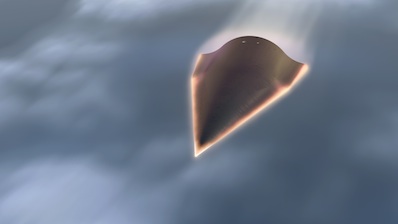BY STEPHEN CLARK
SPACEFLIGHT NOW
Posted: August 11, 2011
A three-stage Minotaur 4 Lite rocket blasted off Thursday from the California coast, accelerating a U.S. military hypersonic glider to blazing speeds on a test flight demonstrating technologies for an unmanned global strike bomber, but officials lost contact with the vehicle and could not confirm the mission's outcome.

Artist's concept of the Hypersonic Test Vehicle 2. Credit: DARPA
The solid-fueled Minotaur 4 Lite rocket launched at 7:45 a.m. Pacific time (10:45 a.m. EDT; 1445 GMT) and rolled on a trajectory west from Vandenberg Air Force Base. It was expected to reach a speed of 13,000 mph in about three minutes.
Launch was delayed from Wednesday by poor weather over the Pacific Ocean.
The three-stage version of the launcher uses retired Peacekeeper missile motors. A fourth stage can be added for orbital launches with satellite payloads.
The Pentagon's second Hypersonic Test Vehicle, a throwaway high-speed aerodynamic testbed, was programmed to separate from the Minotaur rocket a few minutes after liftoff. The vehicle was designed to orient itself to fall back into the atmosphere and execute maneuvers to control its altitude and velocity before falling in the Pacific Ocean near the U.S. Army's Reagan Test Site at Kwajalein Atoll in the Marshall Islands, according to the military.
The HTV project is managed by the Defense Advanced Research Projects Agency, or DARPA, the Defense Department's research and development unit.
Posting updates on DARPA's Twitter account, the agency said they lost the communications signal from the HTV a few minutes after launch.
"Downrange assets did not reacquire tracking or telemetry," one Twitter update said. The vehicle "has an autonomous flight termination capability. More to follow."
A DARPA spokesperson did not respond to questions Thursday afternoon.
The second HTV flight, called HTV 2b, aimed to complete unfinished testing from an initial demonstration in April 2010. During that flight, the arrowhead-shaped aircraft lost control and had to be destroyed by an on-board termination system.
Engineers blamed the mishap on flight control authority limitations as the HTV soared through the edge of space at more than 10,000 mph. Its control flaps were unable to maintain the vehicle's attitude, causing the craft to yaw and roll before it autonomously commanded the termination of the flight, according to DARPA.
Officials adjusted the second HTV's center of gravity, decreased its programmed angle of attack and used the craft's reaction control system thrusters to help out the flaps keep the vehicle under control, DARPA said in a press release.
Despite the abridged flight, last year's test gathered 139 seconds of useful aerodynamic data and verified navigation, communications and control systems.
The taste of data from the shortened first HTV flight was still more than could have been efficiently collected inside wind tunnels on the ground, according to Air Force Maj. Chris Schulz, the HTV 2 program manager.
Wind tunnels are able to simulate long-term hypersonic flight conditions up to velocities around Mach 15. Beyond that, engineers need special wind tunnels called impulse tunnels to capture data milliseconds at a time. It would have required years, tens of millions of dollars and several hundred impulse tunnel tests to replicate data from the April 2010 demo flight.
"And even then, we wouldn't know exactly what to expect based solely on the snapshots provided in ground testing," Schulz said. "Only flight testing reveals the harsh and uncertain reality."
It's unclear how much data was collected on Thursday's mission.
About three minutes after launch, the Minotaur rocket should have accelerated the HTV payload to about 20 times the speed of sound, fast enough to travel from New York to Los Angeles in 12 minutes. Once the glider was released, it was supposed to first prepare to re-enter Earth's atmosphere, then soar through the edge of space with a series of programmed banks to control the craft's speed and trajectory.
Temperatures outside the vehicle were expected to reach 3,500 degrees Fahrenheit during the most extreme part of the flight, hot enough to melt steel. Tracking ships, planes and space assets were positioned to collect data during the flight, and the HTV was covered in sensors to study how the vehicle responds throughout the mission.
At the end of the mission, the HTV was to make a destructive dive into the ocean.
DARPA says the HTV craft featured a high lift-to-drag aerodynamic shape, lightweight thermal protection structures and autonomous guidance, control and flight safety systems. The vehicles were manufactured by Lockheed Martin Corp.
This pair of HTV tests was part of DARPA's Falcon project. An Air Force-led follow-on flight called the Conventional Strike Missile is planned launch on another Minotaur rocket in mid-2013, in which another HTV will be outfitted with a conventional warhead to be directed toward a target downrange.
Thursday's launch was the fourth flight of a Minotaur 4 rocket. Two of the missions hauled satellites into low Earth orbit, in addition to the dual HTV launches.
Another Minotaur 4 launch is scheduled for Sept. 27 from the Kodiak Launch Complex in Alaska. It will orbit the military's TacSat 4 satellite with an experimental UHF communications package.


No comments:
Post a Comment